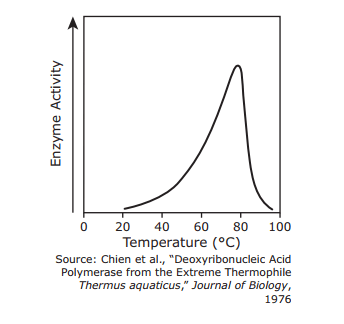
TEKS Biology High School - B.9.C: Enzymes
Quiz by TEKS Biology High School
High School - Biology
Science (2010) (Archived)
Texas Essential Knowledge and Skills (TEKS)
Feel free to use or edit a copy
includes Teacher and Student dashboards
Track each student's skills and progress in your Mastery dashboards
With a free account, teachers can
- edit the questions
- save a copy for later
- start a class game
- automatically assign follow-up activities based on students’ scores
- assign as homework
- share a link with colleagues
- print as a bubble sheet
9 questions
Show answers
- Q1Taq polymerase is an enzyme used in the polymerase chain reaction (PCR) to replicate fragments of DNA. A study published in 1976 examined the properties of Taq polymerase after the enzyme was isolated from Thermus aquaticus, a thermophilic bacterium that lives in the hot springs of Yellowstone National Park. The graph shows one of the results of the study. Which statement about enzyme activity is best supported by this graph?An enzyme works equally well in bacteria that are adapted to high temperatures and in eukaryotic cells such as human cellsAn enzyme functions best under specific temperature conditionsAn enzyme must be composed of multiple polypeptides, or subunits, to be active.An enzyme’s rate of activity increases with time until it becomes inactive.30sB.9.C: Enzymes
- Q2Some foods that are rich in complex carbohydrates can be difficult to digest. Gas often forms as the foods are slowly digested by bacteria in the large intestine. The advertisement is for a nutritional supplement that prevents intestinal gas. Which of the following represents evidence that could be used to support the claims about this product?Consuming enzymes specific for carbohydrate digestion helps the body digest complex carbohydrates more quickly in the stomach and small intestineSome nutritional supplements add beneficial bacteria to a person’s diet. These bacteria populate the stomach and prevent carbohydrate digestion.Complex carbohydrates are found in vegetables and grains, which are good sources of fiber, vitamins, antioxidants, and minerals. Vegetables and grains are known to reduce the risk of heart diseaseSome nutritional supplements provide vitamins and minerals that are missing from a person’s diet. These types of nutritional supplements contain important nutrients that reduce the risk of malnutrition30sB.9.C: Enzymes
- Q3The diagram represents one way an enzyme can be inhibited. Which statement explains the effect of an inhibitor on an enzyme?The enzyme will likely be attacked by immune cellsA substrate will be unable to attach to the enzymeThe enzyme will be unable to produce more enzymesA substrate will be able to bond with the enzyme30sB.9.C: Enzymes
- Q4People who have Alzheimer’s disease experience an increasing loss of brain function and cognition over time. Alzheimer’s is characterized by a buildup of abnormal protein fragments that damage brain cells. Recently scientists have discovered an enzyme, BACE2, that decreases these abnormal protein fragments in the brain of a person with Alzheimer’s disease. Which statement explains how BACE2 most likely works?BACE2 molecules link several abnormal protein fragments together, forming a complete proteinBACE2 breaks down into smaller pieces that react with the abnormal protein fragments, forming more complex moleculesBACE2 is a reactant that combines with the abnormal protein fragmentsBACE2 speeds up the reaction that breaks down the abnormal protein fragments30sB.9.C: Enzymes
- Q5Fireflies emit light. The production of light by an organism is called bioluminescence. To generate visible light, cells in a firefly’s tail produce thousands of luciferase enzymes. Luciferase binds to a chemical called luciferin. Once bound, the luciferase enzyme speeds up a chemical reaction that combines an oxygen molecule and luciferin to produce oxyluciferin. This reaction requires energy and releases light. Which of the following best describes how the luciferase enzyme speeds up the chemical reaction?Luciferase decreases the amount of energy required for the reaction to startLuciferase increases the amount of time the light is visibleLuciferase increases the number of sites on luciferin that must bind to oxygenLuciferase decreases the temperature of the environment inside the body of the firefly30sB.9.C: Enzymes
- Q6Lactose is found in milk products. It is converted by the body into a usable form in a series of chemical reactions. The diagram shows the series of reactions that convert lactose into a usable form. If Enzyme 2 is denatured, the levels of which substance will increase?Galactose-1-phosphateGalactoseLactoseGlucose-6-phosphate30sB.9.C: Enzymes
- Q7Pepsin and trypsin are two of the digestive enzymes that break down protein. A group of students studied the pH requirements of these enzymes. The graph below shows the results. The students found that pepsin functions best in an acid environment and trypsin functions best in a neutral environment. Based on their observations, pepsin most likely aids in digestion in which part of the human body?IntestinesStomachPancreasMouth30sB.9.C: Enzymes
- Q8Enzymes are proteins that help increase the rate of chemical reactions inside cells. These proteins are composed of many simpler molecules called amino acids. Which of the following suggests that the shape of an enzyme determines the enzyme’s function?Enzymes can be found in all life-formsEnzymes are activated by neighboring moleculesEnzymes can operate in a wide range of conditionsEnzymes are specific to a substrate30sB.9.C: Enzymes
- Q9The graphs show the reaction rate for an enzyme across a range of temperatures and pH. Based on these data, this enzyme functions best at what temperature and pH?Temperature of 37°C and a pH of 6Temperature of 27°C and a pH of 4Temperature of 50°C and a pH of 10Temperature of 40°C and a pH of 860sB.9.C: Enzymes
